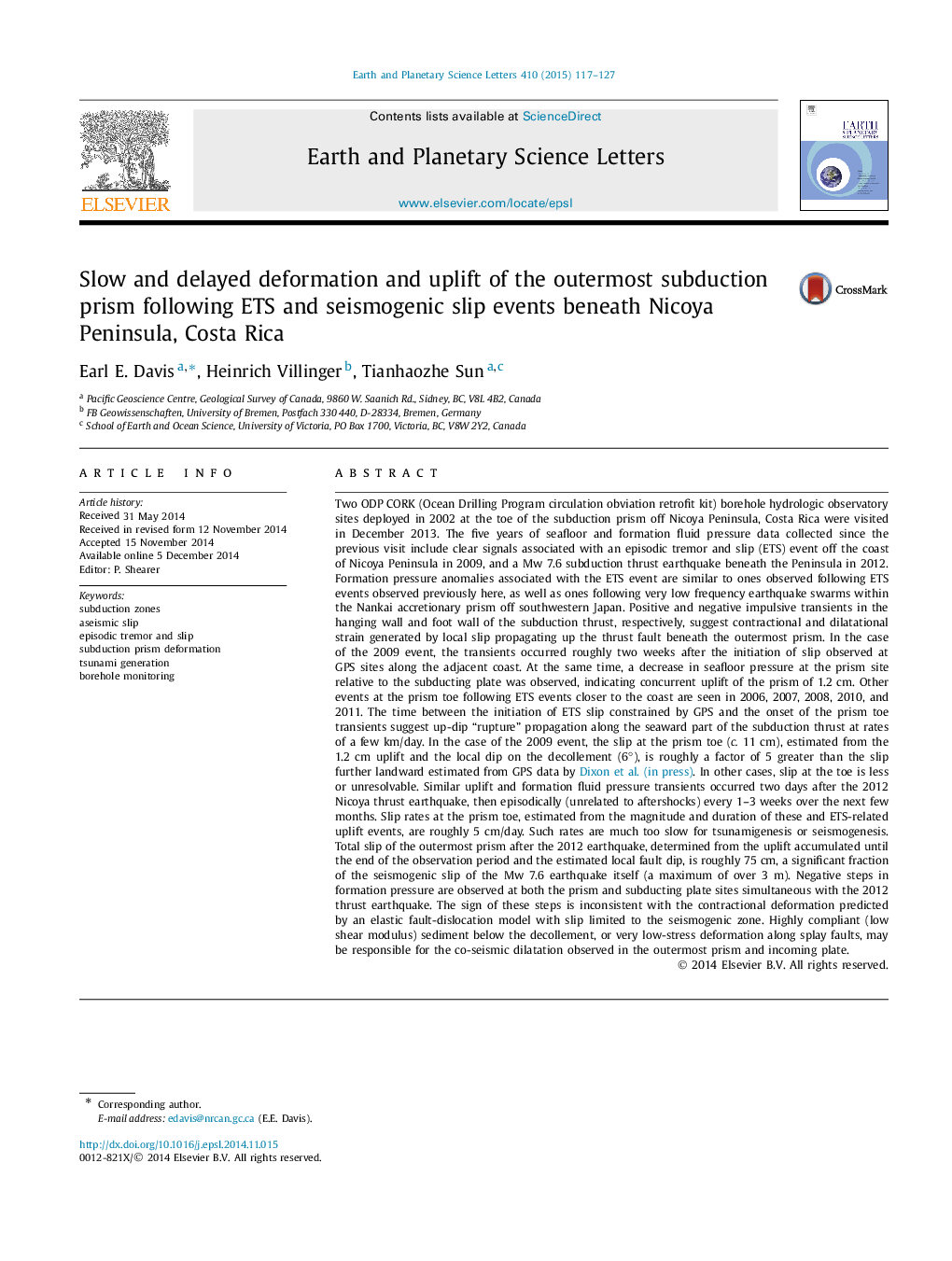| کد مقاله | کد نشریه | سال انتشار | مقاله انگلیسی | نسخه تمام متن |
|---|---|---|---|---|
| 6428458 | 1634746 | 2015 | 11 صفحه PDF | دانلود رایگان |

- Borehole monitoring at subduction prism toe constrains co-seismic and post-seismic strains.
- Dilatational co-seismic strain requires stress relief below or landward of outer prism.
- Seafloor pressure monitoring reveals slow and delayed post-seismic uplift and inferred slip.
- Uplift and correlated formation-pressure transients indicate episodic slip on decollement.
Two ODP CORK (Ocean Drilling Program circulation obviation retrofit kit) borehole hydrologic observatory sites deployed in 2002 at the toe of the subduction prism off Nicoya Peninsula, Costa Rica were visited in December 2013. The five years of seafloor and formation fluid pressure data collected since the previous visit include clear signals associated with an episodic tremor and slip (ETS) event off the coast of Nicoya Peninsula in 2009, and a Mw 7.6 subduction thrust earthquake beneath the Peninsula in 2012. Formation pressure anomalies associated with the ETS event are similar to ones observed following ETS events observed previously here, as well as ones following very low frequency earthquake swarms within the Nankai accretionary prism off southwestern Japan. Positive and negative impulsive transients in the hanging wall and foot wall of the subduction thrust, respectively, suggest contractional and dilatational strain generated by local slip propagating up the thrust fault beneath the outermost prism. In the case of the 2009 event, the transients occurred roughly two weeks after the initiation of slip observed at GPS sites along the adjacent coast. At the same time, a decrease in seafloor pressure at the prism site relative to the subducting plate was observed, indicating concurrent uplift of the prism of 1.2 cm. Other events at the prism toe following ETS events closer to the coast are seen in 2006, 2007, 2008, 2010, and 2011. The time between the initiation of ETS slip constrained by GPS and the onset of the prism toe transients suggest up-dip “rupture” propagation along the seaward part of the subduction thrust at rates of a few km/day. In the case of the 2009 event, the slip at the prism toe (c. 11 cm), estimated from the 1.2 cm uplift and the local dip on the decollement (6°), is roughly a factor of 5 greater than the slip further landward estimated from GPS data by Dixon et al. (in press). In other cases, slip at the toe is less or unresolvable. Similar uplift and formation fluid pressure transients occurred two days after the 2012 Nicoya thrust earthquake, then episodically (unrelated to aftershocks) every 1-3 weeks over the next few months. Slip rates at the prism toe, estimated from the magnitude and duration of these and ETS-related uplift events, are roughly 5 cm/day. Such rates are much too slow for tsunamigenesis or seismogenesis. Total slip of the outermost prism after the 2012 earthquake, determined from the uplift accumulated until the end of the observation period and the estimated local fault dip, is roughly 75 cm, a significant fraction of the seismogenic slip of the Mw 7.6 earthquake itself (a maximum of over 3 m). Negative steps in formation pressure are observed at both the prism and subducting plate sites simultaneous with the 2012 thrust earthquake. The sign of these steps is inconsistent with the contractional deformation predicted by an elastic fault-dislocation model with slip limited to the seismogenic zone. Highly compliant (low shear modulus) sediment below the decollement, or very low-stress deformation along splay faults, may be responsible for the co-seismic dilatation observed in the outermost prism and incoming plate.
146
Journal: Earth and Planetary Science Letters - Volume 410, 15 January 2015, Pages 117-127